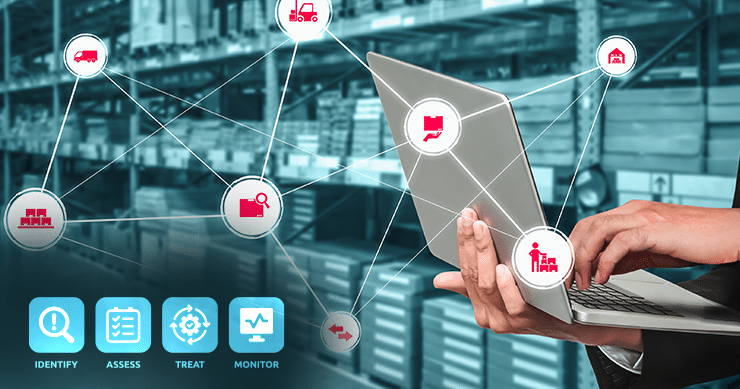Businesses are increasingly relying on third-party vendors to support their operations. As corporate networks grow beyond traditional network perimeters and expand their boundaries to include third-party service providers and global supply chain links, significant risk is introduced along the way. That’s why a well-executed third-party risk management strategy is so important to protect your organization in today’s enmeshed business landscape.

Basic Steps In the TPRM Lifecycle
Vendor Discovery
Begin by identifying the third parties you’re currently working with or those you intend to engage with. Use existing information, integrate with technology solutions, conduct assessments, and assign risk ratings to build a comprehensive third-party inventory.
Evaluation and Selection
During this phase, evaluate potential third parties using criteria specific to your business needs. Consider factors such as internal controls, financial stability, security protocols, and compliance history. The goal is to select partners that align with your organization’s goals and can meet your risk appetite and compliance requirements.
Risk Assessment
Conduct thorough vendor risk assessments to understand the potential risks associated with each third party. Assessments should cover areas beyond cybersecurity, encompassing financial, operational, legal, and reputational risks.
Risk Mitigation
After identifying risks, develop strategies to mitigate them effectively. Establish risk mitigation third party risk management workflows that include risk flagging, risk evaluation against your organization’s risk appetite, and the implementation of controls to reduce risk to an acceptable level. Continuous monitoring should be implemented to detect any changes in risk levels promptly.
Contract Time
During the contracting and procurement stage, ensure that your contracts with third parties include relevant provisions related to risk management, security protocols, data protection, and compliance. Collaborate with legal teams to review contracts and address any potential issues or gaps that may pose risks to your organization.
Reporting and Documenting
Maintaining comprehensive records is essential for compliance and demonstrating adherence to regulatory requirements.
Continuous Monitoring
Monitoring third-party risks is an ongoing process. Implement monitoring mechanisms to detect changes in risk levels. Proactively adapt and respond to emerging risks.
Offboarding
When a third-party relationship ends, a thorough offboarding procedure is crucial. Develop an offboarding checklist to ensure that all necessary measures, assessments, and confirmations are completed before concluding the relationship.
Challenges and Pitfalls in the TPRM Lifecycle
Third parties add multiple layers of complexity to security operations. Many organizations struggle with fragmented digital tools and outdated manual processes, leading to fatigue, noncompliance, operational inefficiencies, missed opportunities, and even cyber-attacks. Here are some challenges commonly encountered in the TPRM lifecycle.
Scaling Challenges
If TPRM is already a struggle, keeping up with your vendor due diligence only becomes more congested as businesses grow. While questionnaires and fill-out- forms have their place in a vendor risk management program, it is nearly impossible to scale as your company grows using a manual approach.
Fragmented Technology
Organizations relying on a patchwork of legacy spreadsheets, homegrown solutions, and customized systems face several issues. These are synonymous with poor user experiences, limited data accessibility, high maintenance costs, and offline processes that increase the risk of non-compliance and data breaches.
Lack of Resources
Most businesses lack the resources to maintain a fit-for-purpose TPRM operating model. The volume of work and complexity involved in properly vetting third-party vendors is a growing concern among business leaders.
Enter Third-Party Risk Management Automation
It can be challenging to get to a point where you feel you are effectively managing your vendors. That’s why an automated vendor risk management program is the future of TPRM.
Automating TPRM allows you to easily keep track of your vendor risk while keeping your VRM relevant to the changing tides. Automation ensures that vendors are onboarded in a smooth, fast, and clean operation. It means easy scanning and tracking, clear risk information on every vendor, and detailed reports. Most importantly, automation allows you to step back with the knowledge that your vendors are in good hands and focus on strategic decisions.
Start Getting Value With
Centraleyes for Free
See for yourself how the Centraleyes platform exceeds anything an old GRC
system does and eliminates the need for manual processes and spreadsheets
to give you immediate value and run a full risk assessment in less than 30 days
Automated Third-Party Management Best Practices
- Streamline third-party risk assessments
Security automation platforms automate the assessment process, allowing organizations to efficiently evaluate the security controls and vulnerabilities of their third-party vendors.
- Automate due diligence
Automation enables the collection and analysis of relevant security information from vendors, streamlining the due diligence process and ensuring comprehensive risk evaluation.
- Enable continuous monitoring
Automation tools facilitate ongoing monitoring of third-party security practices, allowing organizations to proactively identify and address any emerging risks or compliance gaps.
- Automate risk scoring
Security automation platforms can automatically calculate risk scores based on predefined criteria, providing a standardized and objective assessment of the level of risk associated with each vendor.
- Automate risk remediation
Integration with ticketing systems and workflow engines allows organizations to automate the tracking and resolution of identified risks, ensuring timely remediation efforts.
- Encourage vendor communication
Automation tools provide a centralized platform for communication and collaboration with vendors, streamlining the exchange of risk-related information and ensuring clear communication channels.
- Focus on compliance management
Security automation enables organizations to automate compliance assessments, track regulatory changes, and ensure ongoing adherence to security standards and industry regulations.
- Provide centralized documentation and audit trails
Automation platforms offer a centralized repository for storing vendor documentation, contracts, and compliance records, simplifying audit processes and ensuring easy access to relevant information.
- Allocate resources efficiently
By automating manual processes and reducing administrative tasks, security automation allows organizations to allocate resources more efficiently and focus on strategic risk management initiatives.
Features You Need in an Automated TPRM Platform
Streamlined Risk Assessments
Implementing an intuitive risk assessment tool promotes consistency in risk assessments across the organization. This ensures a comprehensive and accurate understanding of the risk landscape associated with third-party and supply-chain relationships.
Due Diligence
An advanced TPRM platform should provide access to industry data, due diligence information, and assessment products. This empowers organizations to make informed decisions based on reliable external sources.
Reporting Capabilities
Manual reporting processes pose significant challenges in TPRM, hindering data analysis, reporting accuracy, and scalability. To improve data quality and reporting efficiency, organizations should ensure they have good reporting and documenting tools.
Risk Visibility
Automation provides real-time insights into the risk landscape associated with third-party vendors, enabling organizations to identify and prioritize risks more effectively.
Centraleyes Can Automate Your TPRM Program
Centraleyes offers businesses a unique third-party risk management tool, allowing companies to fully automate third-party risk management using a single platform to onboard new vendors, assess, categorize, and prioritize them, continually monitor them, and view a comprehensive risk profile for every vendor with real-time remediation dashboards and downloadable reports. The platform shaves off hours of manual labor, allowing you to focus on the more pressing matters at hand with the knowledge that at least your vendor risks are no longer on that list.
The platform’s customized third-party dashboard uses a hybrid risk approach to automatically
provide a clear view of the highest-risk vendors, with actionable guidance on how to mitigate gaps. With real-time threat intelligence and active scanning, you will feel secure in the knowledge that you have strong security practices in place to manage your third- (and fourth!) party risks.
Centraleyes will transform the way you work with your supply chain saving you immeasurable time, money, and resources.
Join our growing list of satisfied users who are effortlessly managing hundreds of vendors as we write.
Start Getting Value With
Centraleyes for Free
See for yourself how the Centraleyes platform exceeds anything an old GRC
system does and eliminates the need for manual processes and spreadsheets
to give you immediate value and run a full risk assessment in less than 30 days





